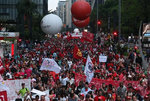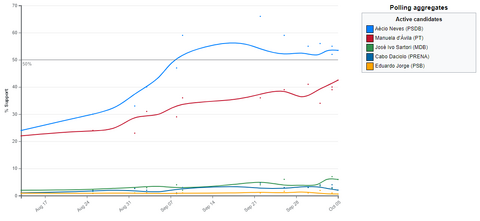| ‹ 2014 | ||||
| Brazil Presidential Election, 2018 | ||||
|---|---|---|---|---|
| Octuber 7, 2018 | ||||

|

|

| ||
| Nominee | Aécio Neves | Manuela d'Ávila | Jose Ivo Sartori | |
| Party | PSDB | PT | MDB | |
| Home state | Minas Gerais | Rio Grande do Sul | Rio Grande do Sul | |
| Running mate | João Doria | Miguel Rossetto | Paulo Skaf | |
| States carried | 24+D.F | 2 | 0 | |
| Popular vote | 63,045,388 | 49,582,429 | 3,045,388 | |
| Percentage | 53,4% | 41,99% | 2,58% | |

| ||||
The 2018 presidential election in Brazil was the country's 8th presidential election after the 1988 Federal Constitution was enacted. President Aécio Neves, of the PSDB, was reelected with more than 60 million votes by the Porto Alegre mayot, Manuela d'Ávila of the PT. Aécio Neves became the fourth president of Brazil to be reelected in the elections and the second of the PSDB to be reelected. Neves took for his second term on March 15, 2019.
Candidate Aécio Neves was the favorite since the first opinion polls. This greatly boosted Brazil's economic growth at the end of 2017. On the other hand, it was criticized for some corruption cases, which made its popular advantage diminish a part. He had a great alliance and supported other parties like MDB and PTB. With Haddad's defeat in the last election, the party went into an internal crisis as to who would be the candidate for the elections. The Party chooses d'Ávila as its candidate.
The election was one of the most polarized and in the history of the country and was known for several cases of fake news between both candidates. Aécio Neves was a great target of this.
Backroud[]
The strenght of the Brazilian Social Democracy Party (PSDB)[]
Since Aécio won the elections in 2014, the PSDB started to invest in its money and gained strength in the state elections, winning 6 Brazilian states. After Aécio took office, the government was characterized as the opposition of Dilma Rousseff and the Workers' Party (PT) and also the return of the FHC era.
And in May the PSDB became the highest paid and richest party in Brazil, with 213 million reais in total. In February 2015, he supported the PMDB candidate, Fábio Ramalho, where he won by 302 votes.
Pro-PT Protests (2015)[]

Pro PT-Protests in São Paulo in 2015
On September 19, 2015, small protests on the streets of São Paulo began to emerge in protests against the Aécio Government. Days later it spreads throughout Brazil. Until the police forces controlled the protests. Grades rivalry between PT and toucans.
Protests started to increase in October 2015, when Aécio Supposedly entered an investigation into Lava Jato, where it ended until November when the president had no affiliation with the crime.
Death of Aloysio Nunes and Appointment of Doria as Vice[]

João Doria and Aécio Neves in November 18, 2015
In November 2015, Aloysio Nunes died of a heart attack. Doctors tried to revive but failed. After the burial, the president of the Chamber Fábio Ramalho would assume the presidency, however the president Aécio refused the proposal, because "he was a very suspicious and corrupt vice".
Aécio decided to choose the governor of São Paulo, João Doria, a great partner and political ally. But the chamber refused, this generated confusion until there was an election for Vice President where the Senate would choose who would be the vice president of Brazil.
João Doria with support from the party itself (PSDB), National Renovating Alliance Party (PRENA), Progressive Party (PP), Brazilian Labor Party (PTB) and Republicans (PRB). Winning by 271, he becomes vice president of the Federative Republic of Brazil.
PSDB nomination[]
| Brazilian Social Democracy Party ticket, 2018 | |
| Aécio Neves | João Doria |
|---|---|
| for president | for vice-president |
| 35th
(2015-) |
25th
Vice-President of Brazil (2015–) |
In the PSDB primaries, Aécio Neves had great ease in the primaries for being president and not having a big rival. He ended up focusing more on the general elections than on the primary.
Aécio Neves ended up winning the elections for 26+ Federal District.On February 2, 2018. Easily winning the election with his deputy Jair Bolsonaro.
PT nomination[]
| Wokers' Party ticket, 2018 | |
| Wokers' Party | |
|---|---|
| Manuela d'Ávila | Miguel Rossetto |
| for president | for vice-president |
| Mayor of Porto Alegre
(2013-2018) |
Federal Deputy of Rio Grande do Sul
(2007 - 2019) |
After Haddad's defeat, In the primaries of the Workers' Party, Manuela d'Ávila became a great candidate for the PT elections, mainly because she is an Independent Woman.
d'Ávilla started giving speeches of love and in favor of the LGBTQ movement. It became a little controversial for promising far-left reforms, which would change Brazil, making it a more extreme left-wing candidate for the Party.
In 1 December , 2017, Manuela d'Ávila won the primaries by 10.3 million votes,with a margin of 4.3% against the former Senator of Parana, Gleisi Hoffmann. D'Ávila's victory was critical of the country's left, because due to its extremism, the PT ended up becoming by the right-wing media as the Party of the Extreme Left.
The MST (Movimento Sem Terra) and several left and extreme left movements ended up supporting d'Ávilla's candidacy.
Others
Brazilian Democratic Movement[]
Since 1994, the Brazilian Democratic Movement (MDB) has been making party nominations primaries, that is, there are no primaries by the popular vote of the people.
In December 2017, the governor of Rio Grande do Sul, José Satori, ended up announcing his candidacy for the Brazilian Democratic Movement. With party support since his candidacy for governor, Satori ended up running for president.
National Renovating Aliance Party[]
After 8 years of coalition with the PSDB-PRENA ends up starting its previews. Depultado Cabo Daciolo ended up winning the preliminaries with 78.8% of the votes, which made him participate in the presidential elections.It was the first time that a non-founding candidate was chosen to dispute the elections.
Polling aggregates[]
From the start, Aécio Neves was by far the favorite in the elections due to his high popularity, while d'Ávila grew a little more over the months. The third candidates, were in the percentage 3.0% or 4.0%.From the start, Aécio Neves was by far the favorite in the elections due to his high popularity, while d'Ávila grew a little more over the months. The third candidates, were in the percentage 3.0% or 4.0%.
Result[]

Result map
Manuela d'Ávila ended up winning only 2 states: Rio Grande do Sul (Natal State) and Piauí (State with a large percentage of PT supporters). While Aécio Neves won the rest of the states of Brazil, he was the candidate that won the most state since the democratization. It was the fourth time that a candidate won in the first round.
Despite the Aécio Neves winning almost all the states, the popular vote was more balanced for Manuela d'Ávilla. d'Ávila won 48 million votes while Aécio Neves won 63 million votes. Aécio ended up being the most voted candidate in the history of Brazil's elections.
| Presidential candidate | Running Mate | Party | Popular vote | ||
|---|---|---|---|---|---|
| Count | Pct | ||||
| Aécio Neves | João Doria | Brazilian Social Democracy Party | 63,045,388 | 53,4% | |
| Manuela d'Ávila | Miguel Rossetto | Woker's Party | 49,582,429 | 41,99% | |
| José Ivo Sartori | Paulo Skaf | Brazilian Democratic Movement | 3,045,388 | 2,58% | |
| Cabo Daciolo | Luciano Bivar | National Renovating Alliance Party | 2,100,455 | 1,78% | |
| Eduardo Jorge | Beto Albuquerque | Brazilian Socialist Party | 296,858 | 0,25% | |
Map[]
|
|












